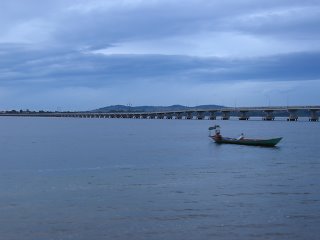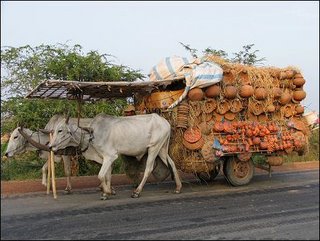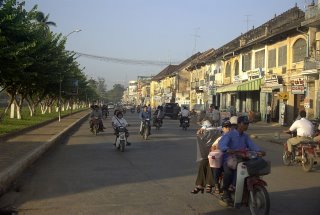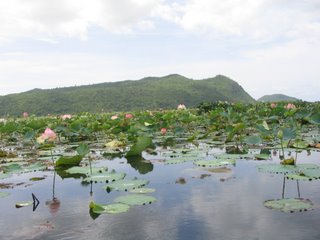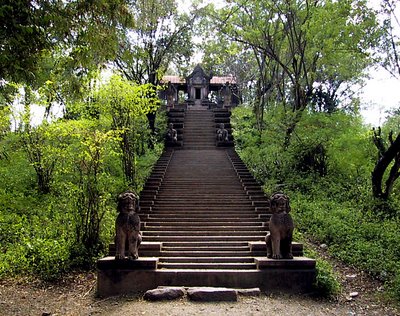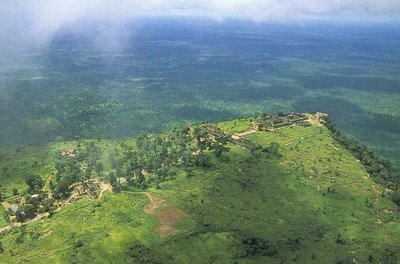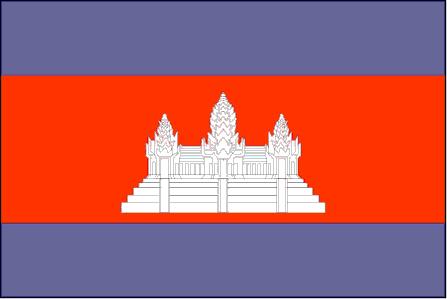CAMBODIA

Cambodia is a country in Southeast Asia. Most Cambodians live on the fertile plains created by the floodwaters of the Mekong River, or near the Tonle Sap (Great Lake) and Tonle Sap River northwest of Phnom Penh. Phnom Penh is Cambodia's capital.
Fact File
Land Area: 181,035 square kilometers. It is bordered to the North by Thailand and Laos; to the East and the South by Vietnam; and to the South and the West by the Gulf of Siam, and Thailand.
Population: Total population is approximately 11,437,656 million (1998). Cambodia comprises a variety of people who are commonly given the name Khmer. Khmer people account for about 90% of citizens, 10% various ethnic background-Chinese, Vietnamese, Chams(Khmer Muslims) and Hilltribes(Khmer Loeu).
Capital: Phnom Penh, 41 square kilometers, is considered as the centre of Industry, Administration, Commerce, and Tourism. The Population is around 1 million.

Climate: Cambodia is situated within a tropical zone, where the average temperature is 27 ºC, average minimum 16 ºC. There are two seasons- the monsoon season and dry season. The humid, rainy season lasts from April to Octobor due to Southwestern monsoons with temperature ranging from 27-35 ºC. The cool, dry season lasts from November to March with temperature ranging from 17-27 ºC.December to January is the coolest period.
Religion: The official religion is Theravada Buddhism. Ninety percent of Khmers are of this religion. The country also has minority religions such as Muslims, Christians.

Language: The official language is Khmer. It is part of the Mon-khmer family. English has gained its popularity these days.
Local Time: 7 hours ahead of GMT (Greenwich Mean Time)
Currency: Riel
PHNOM PENH
PHNOM PENH
The capital of the Kingdom of Cambodia, Phnom Penh, is located at the confluence of three rivers - the Mekong, the Bassac and Tonle Sap. The city is divided into three sections - the north, an attractive residential area; the south or the French part of the city with its ministries, banks and colonial houses; and the centre or the heart with its narrow lanes, markets, foods stalls and shops.Phnom Penh means Hill(Phnom) of lady Penh, who found it in 1372.The first establishment did not last long; the capital moved from one place to another. The capital Phnom Penh was sixth after Nokor Phnom, Angkor Wat, Longvek, Srey Sonthor, and Oudong. At the end of 19th century, the capital moved to Phnom Penh again and still remain the same up to the present time.Covers an area of 41 square Kilometres, Phnom Penh is a major political, economic, cultural, communication, and tourism centre for home and world service.

ROYAL PALACE Royal Palace was built in 1866 by King Norodom; the Royal Palace is now home to the king of Cambodia. The palace is actually a number of structure within a pagoda-style compound. An awe-inspiring sight, the throne room, or the main building has a tiered roof topped by 59m tower.
 INDEPENDENCE MONUMENT:
INDEPENDENCE MONUMENT:
The monument was built in 1958 to symbolise the independence that Cambodia gained from France in 1953. The French fully abandonned their interests in Indochina following defeat by the Vietnamese at the battle of Dien Bien Phu in May 1954. Independence is marked in Cambodia on the 9th November. The monument has a unique and peculiar style and doubles as a memorial to Cambodian.
 NATIONAL MUSEUM
NATIONAL MUSEUM
The NATIONAL MUSEUM of Cambodia is housed in a graceful terracotta structure of traditional design (built 1917-20) just north of the Royal Palace. It is open Tuesday to Sunday from 8 to 11 am and from 2 to 5 pm;photography is prohibited inside. The School of Fine Arts has its headquarters in a structure behind the main building.


 WAT PHNOM
WAT PHNOM
You may also want to check out WAT PHNOM which sits on a tree covered hill about 30m high in the northeast of the city. It is said that the first pagoda was built in 1373 to house four statues of the Buddha deposited here by the Mekong river. It was discovered by a woman named Penh. Thus, the name Phnom Penh, the hill of Penh.
The people believe that this temple is powerful in that anyone who makes a wish will have it granted.
It is not surprising to see many people coming here to pray for protection or healing. Many bring lotus flowers as offerings for prayers answered. At the bottom of the hill is a small zoo, but its most endearing residents, the monkeys, live free in the trees.

CENTRAL MARKET
A visit to the markets and market halls is a must as they give an opportunity to be acquainted with the country's local products and also to buy textiles, antiques, gold and silver jewellery.
The four wings of the yellow coloured Central Market are teeming with numerous stalls selling gold and silver jewellery, antique coins, clothing, clocks, flowers, food, fabrics, shoes and luggage.
KIRIROM NATIONAL RESORT
 KIRIROM NATIONAL RESORT
KIRIROM NATIONAL RESORT
Located at Phnom Sruoch district in the province of Kampong Speu, Kirirom National Park is established on a seven hundred meters hill covering an area of over thirty five thousand hectares in the Elephant Mountains. The name 'Kirirom' meaning Mountain of Joy was given to it by the King of Cambodia. Kirirom National Park, a high altitude plateau, is known for its unique high elevation pine forest, which forms the headwaters for numerous streams feeding Kampong Speu Town.
This park is part of the 'Southwest Cluster Protected Areas' which include Phnom Bokor, Preah Sihanouk and Kep National Parks. Attractions at this hill station of Kirirom are its spectacular scenery and its astonishing waterfalls. This park is also the home to many endangered species of animals such as pleated gibbon, sun bear and tiger . You can take a ride in the traditional ox-cart ride or trek along the walking trails among the pine trees. This natural resort is located one hundred and twenty kilometers to the west of Phnom Penh.
The Kirirom National Park, whose official name is Preah Suramarith Kossmak, is about 80,000 acres of forested land on a rare plateau in southwestern Cambodia. The elevation is about 2,200 feet, high enough to support a large pine forest quite distinct from most of the country's tropical jungle.
TONLE SAP LAKE

Tonle Sap lake is located in the middle of the country, Cambodia's Greatest Lake, is one of the most unique geographical wonders of the world. The extraordinary biodiversity and hydrology of the Tonle Sap Lake and the Tonle Sap River make it a remarkable ecological wonder of the world.
The Tonle Sap 160 km in length, and 36km in width. During the dry season, the Tonle Sap has a size of 3000 sq-km with a depth of 1 m. During the wet season, it has a size of 10000 sq-km with a depth of 12 m. The Tonle Sap has abundant supplies of fresh water fish.
For centuries the Great Lake people have been able to catch 10 tons of fish per square kilometre and provide the major source of Khmer sustenance. Moreover, for astute bird-watcher, the aquatic habitat attracts thousands of birds and fish-eating waterfowl which flock to the wetlands before the rain begins in June.
Species inhabiting the Lake include carp, catfish, mussel, herring, climbing perch and gourami.
On the banks of the mighty Great Lake and Mekong River, people have celebrated for over two hundred years the changing of Rivers flow. During the rainy season, the Tonle Sap river reverses its direction, flooding the lake, increasing its size almos tenfold, making it the largest freshwater body in Southeast Asia.
During the flood season, water engulfs the surrounding forest, regulating agricultural production by ensuring that the countryside is covered with fresh, fertile silt for rice cultivation.

SIEM REAP

 Siem Reap, is a province located in northwestern Cambodia, on the shores of the Tonle Sap lake. The provincial capital is Siem Reap. The name literally means Siamese defeated referring to the victory of the Khmer Empire over the army of the Thai kingdom of Ayutthaya in the 17th Century.
Siem Reap, is a province located in northwestern Cambodia, on the shores of the Tonle Sap lake. The provincial capital is Siem Reap. The name literally means Siamese defeated referring to the victory of the Khmer Empire over the army of the Thai kingdom of Ayutthaya in the 17th Century.
Located in northwest Cambodia, Siem Reap is the major tourist hub in Cambodia, as it is the closest city to the temples of Angkor. The most recognizable of the temples, Angkor Wat, literally Capital Temple, built by King Suryavarman II the early 12th century provides the largest tourist draw. Recently the city has seen a great deal of expansion, hundreds of hotels, restaurants and shops, catering to both international and Cambodian tourists have opened to serve the influx of visitors.
 Other sites of interest near Siem Reap include Angkor Thom built by Jayavarman VII, Banteay Srei, Ta Prohm, as well as hundreds of other temple ruins. Angkor, and the surrounding area that would later become known as Siem Reap, faced repeated invasions from the Thais, and ceased to be the capital after a seven-month siege in 1431. The capital was moved to Phnom Penh in 1432, and then to Lovek and Oudong, before moving back to Phnom Penh in 1866.
Other sites of interest near Siem Reap include Angkor Thom built by Jayavarman VII, Banteay Srei, Ta Prohm, as well as hundreds of other temple ruins. Angkor, and the surrounding area that would later become known as Siem Reap, faced repeated invasions from the Thais, and ceased to be the capital after a seven-month siege in 1431. The capital was moved to Phnom Penh in 1432, and then to Lovek and Oudong, before moving back to Phnom Penh in 1866.
The province is subdivided into 12 districts: Angkor Chum, Angkor Thum, Banteay srei, Chi Kraeng, Kralanh, Puok, Prasat Bakong, Siem Reab, Soutr Nikom, Srei Snam, Svay Leu, and Varin.

ANGKOR WAT Angkor Wat, World heritage, was built by King Suryavarman II in the XIIth Century and was dedicated to Brahmanism. Angkor Wat is 6 Km from Siem Riep town and covers an area of 200 hectares.



SIHANOUK VILLE
 SIHANOUKVILLE - Beach Resort
SIHANOUKVILLE - Beach Resort
'Beach town', 'port community', 'fledgling resort destination' - all describe Sihanoukville, Cambodia's premier beach town. Sihanoukville's white sand beaches and warm Gulf of Thailand waters combine with a laid back, beachy atmosphere to provide a great little tropical getaway. Sihanoukville is a place to unwind by the beach, enjoy the fresh from-the-ocean seafood, take in a snorkeling or scuba trip, and generally slow-down, lay back and chill-out. Sihanoukville has a different look and feel than most Cambodian towns. Constructed as a port city in the late 1950s, the town is much newer, more urban and cosmopolitan than most Cambodian provincial cities. Nowadays, Sihanoukville is as much a beach town as it is a port town, catering to beach-going weekenders from Phnom Penh as well as a steadily increasing number of foreign visitors. Still, the pace of life in Sihanoukville is very relaxed. Cows occasionally wander the main road, outside town foreign faces draw smiles and curious stares, and most of the beaches offer only beach umbrellas, thatched roofed eateries, and a growing number of restaurants, bungalows and hotels.
Sihanoukville has a more than ample supply of accommodations, including a 5-star resort complex on Sokha Beach, several mid-range places downtown and at the beaches, a few 'upscale' three-star hotels, and dozens of budget guesthouses, especially on Weather Station Hill (Victory Hill). Considering the moderate number of visitors to Sihanoukville, the town offers a surprising number and variety of restaurants and bars. Fresh seafood, especially crab, prawns and ocean fish, has always been one of the town's biggest draws, but there is also a wide variety of places offering foreign cuisines - Australian, French, Indian, German, Sri Lankan, British, Italian, pizza places, a couple of western bakeries and even a espresso coffee shop. And these days Sihanoukville offers a pretty good night life as well with a wide variety of bars staying open well into the wee hours, especially on Weather Station Hill, in the downtown area, and the beach bars on Ochheuteal, ‘Serendipity’ and Victory Beaches.
Sihanoukville, also known as Kampong Som, or Kampong Saom, is a port city in southern Cambodia on the Gulf of Thailand. The city is the only deep water port in Cambodia and its beaches are rapidly making it popular as a tourist destination.
 Sihanoukville is surrounded by palm-fringed sandy beaches and pristine tropical islands off its south and west coast. Beaches here lies on the west contour of the city, from north to south, namely Victory Beach, Lamherkay Beach, Koh Pos Beach, Independence Beach, Sokha beach, Serendipity Beach and Occheuteal Beach. The most popular beaches are Occheuteal, Sokha, Independence and Victory. Tourist are allowed island hopping, diving, snorkeling and game fishing at the islands nearby.
Sihanoukville is surrounded by palm-fringed sandy beaches and pristine tropical islands off its south and west coast. Beaches here lies on the west contour of the city, from north to south, namely Victory Beach, Lamherkay Beach, Koh Pos Beach, Independence Beach, Sokha beach, Serendipity Beach and Occheuteal Beach. The most popular beaches are Occheuteal, Sokha, Independence and Victory. Tourist are allowed island hopping, diving, snorkeling and game fishing at the islands nearby.
Sokha Beach Sokha Beach is located just west of Serendipity Beach . This beach is privately owned and is the first luxury beach hotel in Cambodia. It provides many facilities with a wide white sandy beach; if you are not staying at the hotel the guards may or may not stop you from going on to the beach.
Independence Beach Independence Beach is located next to Sokha Beach on its west. The beach was named after the old Independence Hotel. This beach offers a good stretch of clean sand.
Situated at the northern end of the beach is Independence Hotel and Koh Pos Beach, the nice tiny island only 800m off the coast. Koh Pos offers cool shades but rocky waters.
Victory Beach Victory beach is situated at the furthest north of the peninsula of Sihanoukville. It was the original backpacker beach and still popular with budget travelers. At the northern end of the beach is located the deep sea port. Thus, apart from white sand and blue sea, this beach offers a good spot to enjoy the scenes of sunset. At the further south of Victory Beach is another small strand of sand called Lamherkey Beach where the Hawaii Seaview Restaurant is located. It is the place where a French/ Cambodian construction team laid groundwork for the construction of the new Port of Kampong Som during 1950s. At this beach, you can hire a boat to nearby islands.
Islands
There are more than a dozen islands off the coast of Sihanoukville for tourists to hop around. Most of them are yet to be developed for an overnight stay with the exception of Bamboo Island, which is also called Koh Russei. Many guesthouses, restaurants and cafes on Ochteal Teal Serendipity beach offer trips and packages to these islands.Soon Nail Island (also called Magic Island because it looks like a mushroom) will have a hotel run by the folks from the snake house. They already have a pier and most of the hotel and restaurant are finished.
Koh Rong Koh Rong is situated west of the Sihanoukville coast. It offers the fantastic strand of beach on its southwest, stretching about 5 km. It has fresh water resources on the island and a bustling fishing community on the southeast with basic supplies including fresh water, fish and crab.
Koh Rong Samlon Koh Rong Samlon is a bit smaller than Koh Rong and situated on its south. Beautiful beaches are on the east coast, where a large heart-shaped bay with some shellfish cultivation is located, and on the north shoreline facing Koh Rong.
Koh Tang Koh Tang is located quite far from the main shoreline of Sihanoukville. Going there needs trippers to stay overnight on board. It offers interesting diving spots most of which are not frequently explored. The island is home to a military outpost and travelers should expect to be boarded by military personnel when out at the island.
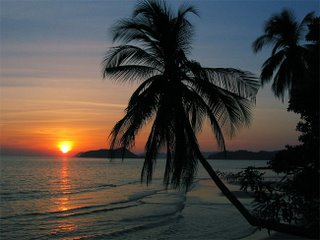
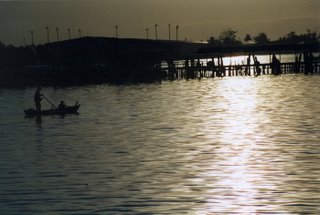
PAILIN
 Pailin is a city (krong) in the west of Cambodia near the border of Thailand. Until 2001 Pailin was part of the Battambang Province, but was then elevated to city status and thus became a province and autonomous zone of its own.
Pailin is a city (krong) in the west of Cambodia near the border of Thailand. Until 2001 Pailin was part of the Battambang Province, but was then elevated to city status and thus became a province and autonomous zone of its own.
The province is divided into two districts: Pailin, and Sala Krau
KEP
Kep (also known as Keb) is a municipality in Cambodia with the status of a province. It is subdivided into two districts. Kep, which is located just a few kilometers from the border with Vietnam, used to be Cambodia's most popular beach town but has fallen on hard times in recent years. Many of Kep's villas are abandoned, but some of the town's former splendor is still apparent. The ocean is lined with wide sidewalks and large statues that now seem largely out of place. The king built a palace overlooking the Gulf of Thailand, but it was never furnished and now sits empty. A good, paved road connects the town with Kampot. Kep's beaches are mostly mangrove and black rock rather than the white sands of Sihanoukville, but Rabbit Island is just a short boat ride away. Kep appears to be experiencing something of a renaissance, with several mid-range and luxury guesthouses and bungalows recently open or under construction. The town's seafood is cheap, plentiful and delicious - particularly the crabs. In addition, Kep is home to an extensive national park.
KOH KONG
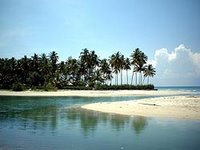 Koh Kong is a province of Cambodia. Its capital is Krong Koah Kong.
Koh Kong is a province of Cambodia. Its capital is Krong Koah Kong.
The province is subdivided into 8 districts : Botum Sakor, Kiri Sakor, Kaoh Kong, Smach Mean Chey, Mondol Seima, Srae Ambel, Thma Bang, and Kampong Seila.
KAMPOT
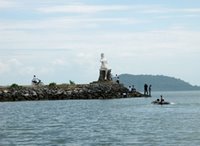 Kampot is a southern province of Cambodia. Its capital is Kampot. The province is subdivided into 8 districts : Angkor Chey, Banteay Meas, Chhuk, Chum Kiri, Dang Tong, Kampong Trach, Kampot, and Kampong Bay.
Kampot is a southern province of Cambodia. Its capital is Kampot. The province is subdivided into 8 districts : Angkor Chey, Banteay Meas, Chhuk, Chum Kiri, Dang Tong, Kampong Trach, Kampot, and Kampong Bay.
 KAMPOT
KAMPOT
Is a small town on the Tuk Chhou River, 5km inland from the sea. Fishing and farming are the main activities; durians and melons grow in abundance.
To the south near the river is the GPO and telecommunications building. At the north end of town, about 1.5 km away, is the Central Market, with foodstalls. All Kampot transportation is concentrated within range of the market-cycle, motors, taxis, trucks, and buses.
TAKEO
 Takéo is a province of Cambodia. Its capital is Takéo.
Takéo is a province of Cambodia. Its capital is Takéo.
The province is subdivided into 10 districts : Angkor Borei, Bati, Bourei Cholsar, Kiri Vong, Kaoh Andaet, Prey Kabbas, Samraong, Doun Kaev, Tram Kak, and Treang.
KRATIE
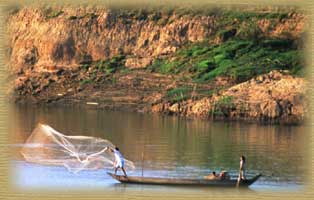 Kratié is a province of Cambodia. Its capital is Kratié.
Kratié is a province of Cambodia. Its capital is Kratié.
It is subdivided into 5 districts :Chhloung, Kracheh, Preaek Prasab, Sambour, and Snuol.
 KRATIE HOME OF FRESHWATER DOLPHINS
KRATIE HOME OF FRESHWATER DOLPHINS
Is a sleepy Mekong River town situated on the east bank of the mighty river? It’s very picturesque with sandbars and big islands out front and bends in the river. Unlike in many towns around Cambodia, the war years were fairly kind to the French architecture and the roads, at least in the town itself. There are some nice-looking homes of French and Khmer style scattered about, adding to the pleasant feel of the place.
The rare freshwater Irrawaddy dolphins make their home in the Mekong River, just north of Kratie. With only around fifteen to twenty remaining, they are worth a visit.
Whether you are just on a trip seeing the river towns along the Mekong or taking a full circuit trip around the east and northeast, Kratie is a nice place to spend a night or two.
 Kampy Resort:
Kampy Resort:
Is the great natural resort where is home to Dolphins. When we travel along the National Road No. 7 to the North about 15Km from the provincial town, we will arrive at abridge of Prek Kam Py where we have seen a very novel view of the Mekong River consisting of thousands of islands full of green water plants. Usually from January to May, there are local and international visitors, who call on the Kam Py resort for swimming, especially during the Khmer New Year. Kam Py resort has special features such as:
- The resort is closed to the National Road, assured safety and has large parking site for motorcycles and cars.- The riverbank is full of sand, and there are many islands assuring the visit of thousands of visitors.
- The water is clear as mirror, has 0.5-1.30 meter depth and flows with
undangerous speed.
Kam Py resort has not only the good natural manner, but also been provided the good services for visitors such as the crossing bridge, floating cottages, soft-drink shops, restaurants, emergency agency, guards and security as well. Nowadays, the provincial tourist office has endeavored to upgrade arranging the resort to be better and more attractive.
KAMPONG CHAM
Kampong Cham is a province in the east of Cambodia. Its capital is Kampong Cham.
The province is subdivided into 16 districts: Batheay, Chamkar Leu, Cheung Prey, Dambae, Kampong Cham, Kampong Siem, Kang Meas, Kaoh Soutin, Krouch Chhmar, Memot, Ou Reang Ov, Ponhea Kraek, Prey Chhor, Srei Santhor, Stueng Trang, and Tboung Khmum.

KAMPONG SPEU
Kampong Speu is a province of Cambodia. Its capital is Kampong Speu.
The province is subdivided into 8 districts:Basedth, Chbar Mon, Kong Pisei, Aoral, Odongk, Phnum Sruoch, Samraong Tong, and Thpong.
KANDAL
Kandal is a province of Cambodia. Its capital is Ta Khmau (lit. Black grandfather). The province completely surrounds, but does not include, the national capital Phnom Penh.
The province is subdivided into 11 districts: Kandal Stueng, Kien Svay, Khsach Kandal, Kaoh Thum, Leuk Daek, Lvea Aem, Mukh Kampul, Angk Snuol, Ponhea Lueu, S'ang, and Ta Khmau.
SVAY RIENG
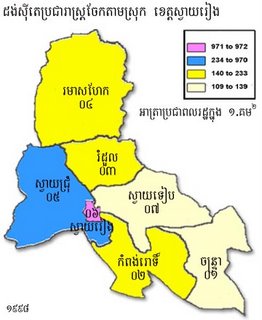 Svay Rieng is a province in the southeast of Cambodia. Its capital is Svay Rieng.
Svay Rieng is a province in the southeast of Cambodia. Its capital is Svay Rieng.
The province is subdivided into 7 districts: Chantrea, Kampong Rou, Rumduol, Romeas Haek, Svay Chrum, Svay Rieng, and Svay Teab.
PREY VENG
Prey Veng is a province of Cambodia. Its capital is Prey Veng.
The total land area is about 4,883 km² that equal to 2.70% of the total land area of Cambodia (181,035 km²), which consisting of 445.18 km² or 9.12% are human settlements, 3,100 km² 63.49% are agriculture land areas, 194.61 km² or 3.99% are forest areas, 1,082.86 km² or 22.18% are public land, infrastructures and water bodies, and the remaining 60.35 km² or 1.24 % are nonused areas.
The total population is 1,025,331 person or 7.64% of the total population 13,413,892 person in Cambodia (2001, provincial government data) with growth rate 2.40%, which consisting of 483,759 person or 47.18% are male and 541,572 person or 52.82% of female. In the above number are also consisting of 825,818 person or 80.54% are farmers, 140,685 person or 13.72% are fishermen, 44,561 person or 4,35% are traders, 14,267 person or 1.39% are government’s officers.
The average density 209.98 person per km².
The province is subdivided into 12 districts: Ba Phnum, Kamchay Mear, Kampong Trabaek, Kanhchriech, Me Sang, Peam Chor, Peam Ro, Pea Reang, Preah Sdach, Prey Veaeng, Kampong Leav, and Sithor Kandal.
KAMPONG CHHNANG
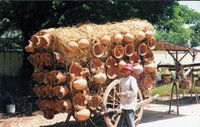 Kampong Chhnang is a central province of Cambodia. Its capital is Kampong Chhnang.
Kampong Chhnang is a central province of Cambodia. Its capital is Kampong Chhnang.
The province is subdivided into 8 districts: Baribour, Chol Kiri, Kampong Chhnang, Kampong Leaeng, Kampong Tralach, Rolea B'ier, Sameakki Mean Chey, and Tuek Phos.
KAMPONG THOM
KAMPONG THOM
‘Kampong Pos Thom’ was the original name of the present call ‘Kampong Thom’. Because originally long time ago, at the dock of Sen river next to a big natural lake, there was a big cave with a pair of big snakes inside. The people living around this area usually saw these big snakes every Buddhist Holiday. Time after that, the snakes disappeared, and the people of that area called Kampong Pos Thom. Then, only short words ‘Kampong Thom’.
Kampong Thom is a province located at the central point of the Kingdom of Cambodia. The province has a total land area of 15,061km2 divided into 8 districts: Baray, Kampong Svay, Stueng Saen, Prasat Balangk, Prasat Sambour, Sandan, Santuk, and Stoung.
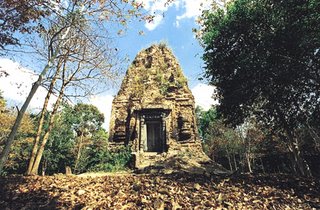 Sambor Prei Kuk Group:Sambor Prei Kuk cluttering sanctuaries were located in Sambor Village, Kampong Cheuteal Commune, Prasat Sambor District, Kampong Thom Provice. King Mahendravarman had reigned form 607 to 616, was a son of a king Sambor Prei Kuk style characterized the real khmer telent. After right received influence and developed her own arts sufficient to the modern development. Arts and civilization of Angkor was the great achievement in Southeast Asia. The well-known city was called Isanapura is presently located at Sambor Prei Kuk, Kampong Thom Province. Sambor Prei Kuk is 25km north of Provincial Town of Kampong Thom. By observation, there are 52 small and big sanctuaries are in fairly good condition, the other 52 sanctuaries were fallen down and buried into the ground, and then became small hills. The sanctuaries were built of brick and limestone with the decoration of bas-relief on the scenery walls. The foundation of sanctuary was made of laterite, false door, diamond column and the sculptures were made of sandstone.
Sambor Prei Kuk Group:Sambor Prei Kuk cluttering sanctuaries were located in Sambor Village, Kampong Cheuteal Commune, Prasat Sambor District, Kampong Thom Provice. King Mahendravarman had reigned form 607 to 616, was a son of a king Sambor Prei Kuk style characterized the real khmer telent. After right received influence and developed her own arts sufficient to the modern development. Arts and civilization of Angkor was the great achievement in Southeast Asia. The well-known city was called Isanapura is presently located at Sambor Prei Kuk, Kampong Thom Province. Sambor Prei Kuk is 25km north of Provincial Town of Kampong Thom. By observation, there are 52 small and big sanctuaries are in fairly good condition, the other 52 sanctuaries were fallen down and buried into the ground, and then became small hills. The sanctuaries were built of brick and limestone with the decoration of bas-relief on the scenery walls. The foundation of sanctuary was made of laterite, false door, diamond column and the sculptures were made of sandstone.
BATTAMBANG
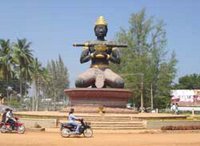 Battambang is Cambodia’s second largest city. It is in the northwest of the country, and its capital is Battambang. The name literally means loss of stick referring to a legend of Preah Bat Dambang Kranhoung (Kranhoung Stick King).
Battambang is Cambodia’s second largest city. It is in the northwest of the country, and its capital is Battambang. The name literally means loss of stick referring to a legend of Preah Bat Dambang Kranhoung (Kranhoung Stick King).
The province is subdivided into 13 districts (srok):Banan, Thma Koul, Bat Dambang, Bavel, Ek Phnom, Moung Ruessei, Rotanak Mondol, Sangkae, Samlout, Sampov Loun, Phnum Proek Kamrieng, and Koas Krala.
PURSAT
Pursat is a province in the west of Cambodia. Its capital is Pursat.
The province is subdivided into 6 districts: Bakan, Kandieng, Krakor, Phnum Kravanh, Sampov Meas, and Veal Veaeng.
STUNG TRENG
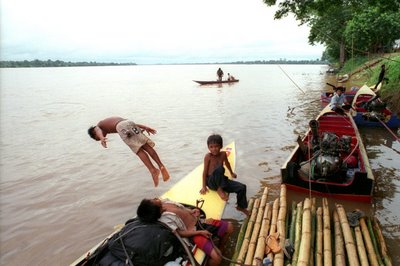 Stung Treng is a northern province of Cambodia.
Stung Treng is a northern province of Cambodia.
The province is subdivided into 5 districts: Sesan, Siem Bouk, Siem Pang, Stung Treng, Thala Barivat.
Stung Treng is now a peaceful town rebuilding itself, the beauty of this province can be breathtaking and surprising. Located near where the Sekong River meets the Mekong this is a traditionally a fishing and farming region and port for many of the west and a gate way to the Lao boarder.
An easy bike ride just outside the town can take you into peaceful farming and fishing villages, with rice fields, old bamboo huts and a vision of how much of Cambodia would have been. A slow boat up the Mekong River can take you to a 3km waterfall that stretches across the span of the Mekong at the Lao boarder. Even the size and power of this waterfall doesn’t deter local fishermen from living there perched on rocks, making outstandingly engineered fishing traps out of bamboo and fallen timber. On return you may be fortunate enough to see one of the last of the protected Mekong River Dolphins.
As a Buddhist country there are many old Pagodas (temples) in Stung Treng housing some beautiful old art work depicting Buddha's story and hold many celebrations and festivals. It is a gateway to seeing the jungle animals, mountains and tribes of Ratanakiri, the Ho Chi Min Trail, or even experiencing a fishing trip on the Mekong. The people of Stung Treng are warm and friendly, the children extremely sociable, many still curious when seeing a foreigner but there's always a “hello”. Much of the food is rural and Lao influenced as in much of this region the local people are both Lao and Khmer. The market is an adventure as many of the local villages bring their catch of the day or unusual vegetables or plants to sell. The many animals that use the roads is amusing and caution needs to be taken getting around!
PREAH VIHEAR
Preah Vihear is a northern province of Cambodia. Its capital is Phnum Tbeng Meanchey.
The province is named after the temple of Prasat Preah Vihear
The province is subdivided into 7 districts: Chey Saen, Chhaeb, Choam Khsant, Kuleaen, Rovieng, Sangkom Thmei, and Tbaeng Mean chey.
 Preah Vihear Temple is located in a pleasant environment with an attractive countryside slightly east of the mid section of the Dongrek Mountains. It is perched on the edge of a giant cliff, about 625 meters above sea level in Preah Vihear Province, Northern part of Cambodia, 625km from the capital city of Phnom Penh.
Preah Vihear Temple is located in a pleasant environment with an attractive countryside slightly east of the mid section of the Dongrek Mountains. It is perched on the edge of a giant cliff, about 625 meters above sea level in Preah Vihear Province, Northern part of Cambodia, 625km from the capital city of Phnom Penh.
ODDAR MEANCHEY
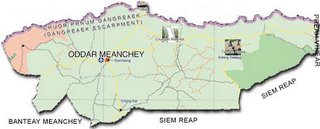 Oddar Meanchey is a province of Cambodia. Its capital is Phum Samraong.
Oddar Meanchey is a province of Cambodia. Its capital is Phum Samraong.
Only 2.6% of households in Oddar Meancheay have access to electricity.
The province is subdivided into 5 districts: Anlong Veaeng, Banteay Ampil, Chong Kal, Samraong, ,and Trapeang Prasat.
BANTEAY MEANCHEY
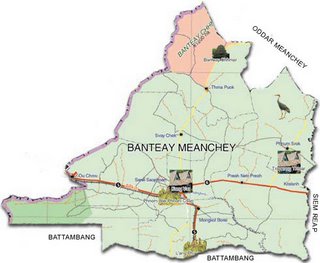 Banteay Meanchey is a Cambodian province. It is in the northwest of the country, and its capital is Sisophon. This province borders Thailand by the west in Poipet.
Banteay Meanchey is a Cambodian province. It is in the northwest of the country, and its capital is Sisophon. This province borders Thailand by the west in Poipet.
The province is subdivided into 8 districts: Mongkol Borei, Phnum Srok, Preah Netr Preah, Ou Chrov, Serei Saophoan, Thma Puok, Svay Chek, and Malai.
RATANAKIRI
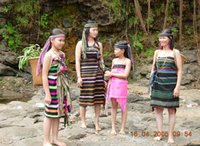 Ratanakiri is a province in Northeastern Cambodia. The word "Ratanakiri" is a derivative of two Cambodian words, combined to mean "place of gems and mountains." Its capital, Banlung, is located in the central highlands of the province, approximately 365 miles (586 kilometers) from Phnom Penh. Lomphat, a small town in the southern plains, is the former capital of Ratanakiri. The province is a popular destination for thousands of tourist every year. Ecotourism abounds, due to lush wildlife and remote tribal villages. Most of the inhabitants of Ratanakiri are indigenous minorities. Ethnic Cambodians make up only 10-20% of the total population.
Ratanakiri is a province in Northeastern Cambodia. The word "Ratanakiri" is a derivative of two Cambodian words, combined to mean "place of gems and mountains." Its capital, Banlung, is located in the central highlands of the province, approximately 365 miles (586 kilometers) from Phnom Penh. Lomphat, a small town in the southern plains, is the former capital of Ratanakiri. The province is a popular destination for thousands of tourist every year. Ecotourism abounds, due to lush wildlife and remote tribal villages. Most of the inhabitants of Ratanakiri are indigenous minorities. Ethnic Cambodians make up only 10-20% of the total population.
The province is subdivided into 9 districts: Andoung Meas, Ban Lung, Bar Kaev, Koun Mom, Lumphat, Ou Chum, Ou Ya Dav, Ta Veaeng, and Veun Sai.
The two main draws that bring tourists to Ratakiri are its indigenous people groups and its wildlife. The province is home to five main ethnic minority groups, the Tampuan, Krung, Jarai, Kachok, and Brao/Kavet. Their tribal lifestyle and village culture are a popular attraction to tourists from Europe and the United States.


























